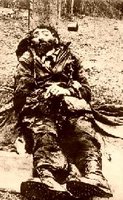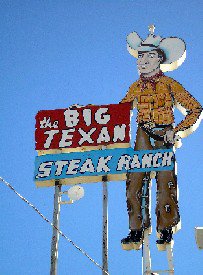Television promoters and producers, listen up! We’ve come up with the ultimate idea to “continue” the popular Deadwood television program without having to pay the now well-recognized (not to mention, expensive) actors of Timothy Olyphant, who plays Seth Bullock, and Ian McShane, who plays Al Swearengen. And for this idea, Alma Garrett, played by Molly Parker, isn’t even a consideration, as that character didn’t exist in real life anyway.
In 1878, about the time that the vast majority of Deadwood's mining claims were consolidated into large corporate holdings, such as the Homestake Mine, a new silver strike erupted in Leadville, Colorado. Miners were transient creatures and at the first talk of new fortune-making opportunities, they wasted no time pulling up stakes and flocking to the next big adventure. Such was the case in Deadwood, when hundreds of its residents, miners and businessmen alike, folded up their holdings in the gulch and headed for the higher plateaus of the Rocky Mountains.
Plus, Leadville had just as many fascinating characters, and as much flair, flamboyance, and violence as did Deadwood. A few of the characters that “we” could bring along into this new series were Deadwood transplants, Charlie Utter, Con Stapleton, Billy Nuttall, and Jack Langrishe. These folks, along with hundreds of others came to Leadville, where Billy Nuttall reinvented the Bella Union, Jack Langrishe brought his entire troupe to entertain a whole new audience of miners, Charlie Utter did a little prospecting, and Con Stapleton obviously ran afoul of something when he died in nearby Denver just eight months after he arrived in Colorado.
Leadville also provides opportunity for a whole new cast of characters as the beautiful Baby Doe steals away the millionaire Horace Tabor from his wife of many years, Doc Holliday deals faro at Hyman’s Saloon and winds up in a gunfight with ex-Tombstone enemy Billy Allen, and the unsinkable Molly Brown and her husband find instant wealth in the mines of Leadville. We also bring into this mix, Leadville visitors Wyatt Earp and Bat Masterson, as well as infamous con-artist “Soapy” Smith.
By 1880, the town was as notorious as Deadwood ever thought of being and its mining rush lasted into 1893, when the “silver panic” gripped the nation.
Leadville provides an opportunity for a new series that could potentially last a lot longer than the Deadwood program and fill the vacuum that so many of us die-hard Deadwood fans are suffering from.
Monday, September 11, 2006
Tuesday, May 23, 2006
John Turnow - The Wild Man of the Wynoochee
 A tale of murder and treasure in the dense forests of Washington, John Turnow's life became a legend. Preferring the unexplored wilderness and wild animals to settlements and people, John Turnow really only wanted to be left alone. But, that would not be the case.
A tale of murder and treasure in the dense forests of Washington, John Turnow's life became a legend. Preferring the unexplored wilderness and wild animals to settlements and people, John Turnow really only wanted to be left alone. But, that would not be the case.When the accidental killing of two young men began to spurt a manhunt, Turnow soon earned such labels as “the Wild Man of the Wynoochee,” “the Cougar Man,” and “a Mad Daniel Boone.”
With each telling, the story became larger and larger until the entire countryside was terrified.
A manhunt began for the "Wild Man" and when he was shot and killed, people came from miles and miles to get a peek at his remains.
If this story is not enough, there is also a tale of lost treasure thought to be buried on the Wynooche River
More ...
Virginia City, Montana - A Lively Ghost Town
Virginia City, Montana - A Lively Ghost Town
Perched high in the Rocky Mountains in a bowl along Alder Gulch, Virginia City got its start when gold was discovered in 1863. It all began when six prospectors were camped along a small stream shaded by alder trees. When one of the prospectors began to find small amounts of gold in his pan, the others immediately joined him and by evening, they had all found enough of the precious metal to know they had made an important strike.
In no time word of the gold find spread and within just months, Alder Gulch was filled with some 10,000 miners living in makeshift shacks, tents, caves, or simply sleeping beneath the trees.
Though the camp was a lawless and violent place filled with desperadoes, rival forces from both sides of the Civil War, and a secret Vigilante Society, it soon gained enough influence to become the Territorial Capital.
However, like many other popular mining camps of the Old West, Virginia City died when the gold began to play out.
Virginia City is now one of the most preserved “ghost towns” in the American West. In addition to the more than 200 historic buildings that are preserved for tourists, Virginia City offers a number of events for visitors that include the Heritage Days & Victorian Ball in August, the Virginia City Players’ variety productions at the Opera House, a narrow-gauge railroad, and the Brewery Follies at Montana's first brewery. Also provided for the some 70,000 visitors who come to Virginia City each year, are museums, shops, restaurants and accommodations.
More ....
Friday, March 31, 2006
An Era Ends As the Telegraph Passes Into History
After 145 years, one of the last remaining vestiges of the Old West has finally come to an end. On January 27, 2006, Western Union sent its final telegram. A sad day, I think, as one more history filled era is forever finished. And why should this be sad, you might ask. We must move forward, technology is changing, dots and dashes have long been replaced by ones and zeros. Be that as it may, this writer thinks it is sad, in the same way it is sad to say goodbye to a loyal employee who has retired after decades of service.
Without fanfare, the telegrams were “just gone” – no retirement party, no chance to bid our last farewell, no final chance to send one more singing telegram at the last minute, before the news was announced by the press. Nothing - but a small announcement on Western Union’s website prior to the ending. Today, their website says not a word about this death of an American tradition - not even a notation in the company’s Historic Timeline.
Think of it - for almost a century and a half, messages of joy, sorrow and success came in those hand-delivered yellow envelopes. The telegraph changed the world when its first message was sent on May 24, 1844 proclaiming “What hath God wrought!” With those first words sent by telegraph inventor Samuel Morse, communication sped through the land in way never known before.
More...
Without fanfare, the telegrams were “just gone” – no retirement party, no chance to bid our last farewell, no final chance to send one more singing telegram at the last minute, before the news was announced by the press. Nothing - but a small announcement on Western Union’s website prior to the ending. Today, their website says not a word about this death of an American tradition - not even a notation in the company’s Historic Timeline.
Think of it - for almost a century and a half, messages of joy, sorrow and success came in those hand-delivered yellow envelopes. The telegraph changed the world when its first message was sent on May 24, 1844 proclaiming “What hath God wrought!” With those first words sent by telegraph inventor Samuel Morse, communication sped through the land in way never known before.
More...
Old West Facts & Trivia - Did You Know?
Well, if you've been "around" for any amount of time, you know that I'm seemingly obsessed with facts. Though often useless bits of information, I just think they're fun! So, for our Old West enthusiasts, here are a few interesting tidbits:
- The term "red light district" came from the Red Light Bordello in Dodge City, Kansas. The front door of the building was made of red glass and produced a red glow to the outside world when lit at night. The name carried over to refer to the town's brothel district.
- Rumor has it that the tradition of spreading saw dust on the floors of bars and saloons started in Deadwood, South Dakota due to the amount of gold dust that would fall on the floor. The saw dust was used to hide the fallen gold dust and was swept up at the end of the night.
- The Infamous Dalton Gang only operated for one year and five months, beginning with a train robbery in Wharton, Oklahoma on May 9, 1891 and ending at the shootout at Coffeyville, Kansas on October 5, 1892.
- Clay Allison, after sitting in a dentist’s chair in Cheyenne, Wyoming, forcibly pulled one of the dentist’s teeth when the doctor drilled on the wrong molar. He would have continued pulling the dentists teeth, but the screams of the dentist brought in people from the street.
- Black Jack Ketchum was the only person ever hung in Union County, New Mexico. According the annals of American Jurisprudence, he was the only criminal decapitated during a judicial hanging. The only other recorded example was in England in 1601.
- The Pony Express was in operation for only nineteen months from April 1860 through October 1861. The Pony Express carried almost 35,000 pieces of mail over more than 650,000 miles during those nineteen months and lost only one mail sack. The typical Pony Express rider was nineteen years old and made $100-$150 per month plus room and board.
These are but a few of the interesting facts of the Old West. Click HERE to see them all.
Saturday, January 14, 2006
A Very Large Steak on Your Route 66 Journey

While not technically on Route 66 today, the original Big Texan Steak Ranch first stood on Route 66 along East Amarillo Boulevard when the steakhouse was built in 1960. It all began in 1959, when Bob Lee went seeking a large steak in the midst of “cow country.” To his surprise, Amarillo sported not a single cowboy steak house, which Lee soon began to rectify.
A year later, The Big Texan Steak Ranch opened, claiming to serve the largest steak in Texas. But simply serving the largest steak wasn’t enough, Lee soon began promoting a Free 72 ounce Steak Dinner if customers could eat the whole thing in less than an hour. It wasn’t long before the promotion gained national attention and travelers thinking of Amarillo, immediately associated it with the Big Texan Steak Ranch, making the restaurant a “must stop” for travelers of the Mother Road.
When I-40 barreled through Amarillo, bypassing Route 66, Lee moved the restaurant nearer the traffic, but the famous steakhouse retained its reputation as a Mother Road landmark. In addition to its more than 40 year old steak promotion and seating for 450 in its restaurant, the Big Texan also sports a motel, Old West entertainment, a gift shop, and even a Horse Hotel, all decorated to resemble an Old West town. The Lee family continues to operate the complex that is not only lots of fun, but also provides a delicious steak.
For those with a very large appetite the Big Texan is a "must stop" on your Route 66 journey through the Texas Panhandle.
Subscribe to:
Posts (Atom)